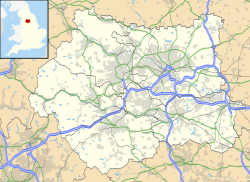Description
The circle has a diameter of about 10 metres (30 ft). [3] It is almost perfectly circular with twenty surviving stones. [3] The stones are set on the inside of a low bank, about 1.8 metres (6 ft) wide. [1] [2] The circle has been described variously as a cairn circle, a ring cairn enclosure, or a stone circle. [4] One third of the circle on the south side has been destroyed by shooting butts. [1] Four large loose stones in the interior may have come from this break. [2] The interior was excavated circa 1846 which revealed a cremation, accompanied by a flint spearhead. [2]
In the 20th century there was additional damage in the form of a subrectangular earthwork mound said to be an "orgone accumulator". [2] Orgone is supposed to be a vital energy or life force which informs the universe, and which can be collected and stored in an orgone accumulator for subsequent use in the treatment of illness. [2]
This page is based on this
Wikipedia article Text is available under the
CC BY-SA 4.0 license; additional terms may apply.
Images, videos and audio are available under their respective licenses.

